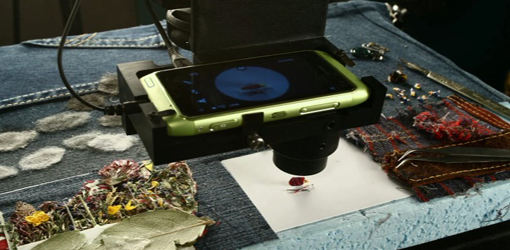Thinking In Scale
Posted on December 16, 2011 | posted by:A couple weeks ago Jamer introduced the idea of scalar thinking, a tool or method used to identify and frame complex problems. Scale is a human construct that was created to organize experience. However, scale is quite diverse, and is understood and perceived differently by everyone. Aly: I was formally trained as an Industrial Designer and scale had a very different meaning, as we used scale directly in relation to 3D modelling products. As technologies enhance the idea of scale starts to shift dramatically, which becomes deceiving but also a very powerful mechanism. Bridgit: And as a formally trained graphic designer, scale started evolved from framed on paper that could fit in a book or in your hands to encompassing larger canvas, like billboards or type on buildings.
Aardman Animation broke the Guinness World Record when they created the worlds smallest (in scale) stop-motion film in celebration of the capabilities of Nokia’s new smartphone called Nokia N8. Mark McCall and Richard Dorey from Aardman state: “achieving our goal of setting a world record with a Nokia N8 is the perfect celebration of the campaign’s core message, it’s not technology, it’s what you do with it.” In designing this particular phone, the Nokia team saw an opportunity to re-frame the function of a phone, looking beyond typical capabilities of a 12-megapixel camera, by combining it with a portable Cellscope/microscope. Together, these two technological objects transform and extend common ideas about what a camera-phone can be used to do. The Cellscope/microscope is an invention created by Fletcher Daniel, a professor from Berkley University to analyze blood samples. The conjunction of the microscope and the Nokia N8 phone allows doctors in remote areas in the developing world to take pictures of cell samples, and send them anywhere in the world for diagnosis. Both Fletcher and Nokia were able to look beyond the traditional capabilities of a phone and identify the need within the developing world. In this way, the phone shifted use from just a 12-megapixels camera to a magnifying power that can identify blood cells. Scalar thinking allowed them to gage the potential of the phone and the opportunity to intervene to help solve larger problems then simply meeting demands of Nokia’s clientele. In celebration of the technology Nokia asked Aardman to put together a film, using these two elements to commemorate the device’s capabilities to change peoples lives. In an artful way, the video highlight’s not how the two technologies relate to blood cells, but rather it illustrates scale.
Aardman decided to really emphasize the power of the mechanisms by highlighting the point at which the virtual world and reality start to combine. For example, the scale of the character cannot be understood until you see her in relation to a finger or a coin. This shift can be seen in the wonderful short film titled “Dot,” (her name) by Nokia and Aardman Animations. The making of the film, like the mechanisms, truly tested the teams’ abilities to work in scale. Aardman Animation constructed an environment, for Dot to act on, that plays with the idea of time and space, in turn, collapsing our sense of scale. As she is 9mm tall, the entire set of the video animation was no more than a metre and a half long, enough space to drastically distort the viewer’s perception of the film. The idea of scalar thinking was not only applied to the building of the environment but also in the way in which it was designed, filmed, and meant to be perceived by the viewers. On average, the team could film about 4 seconds a day. The amount of detail in the hand crafted characters and in each of the scenes of the film required the entire team to re-think their fundamental concepts of both scale and time. Scale had to be reevaluated because her created environment is made up of other objects, like coins and pencil erasers. Time was also reevaluated because, at her scale, to make a stop motion movie flow, requires many frames to make her appear to run and move.
The ability to step back and re-frame a problem is not an easy task, as seen in both the process of making the stop motion film, but additionally in the re-framing of the purpose of objects: to easily send microscopic blood sample images miles away. How do you know when you have stepped back far enough or when it’s appropriate to intervene? Scaling up in the case of the accessibility and capability of the N8 phone, or scaling down as seen in the film creation, can be a daunting idea at times and difficult for us to grasp. However, by understanding how the larger system works in relation to any particular problem, designers can create new possibilities that we might not have seen before. Thus, scalar thinking is about learning and designing at the same time as continuous design challenges present themselves to us and the world, and the universe and cosmos and on and on…
http://www.wk.com/campaign/dot
Aly and Bridgit

